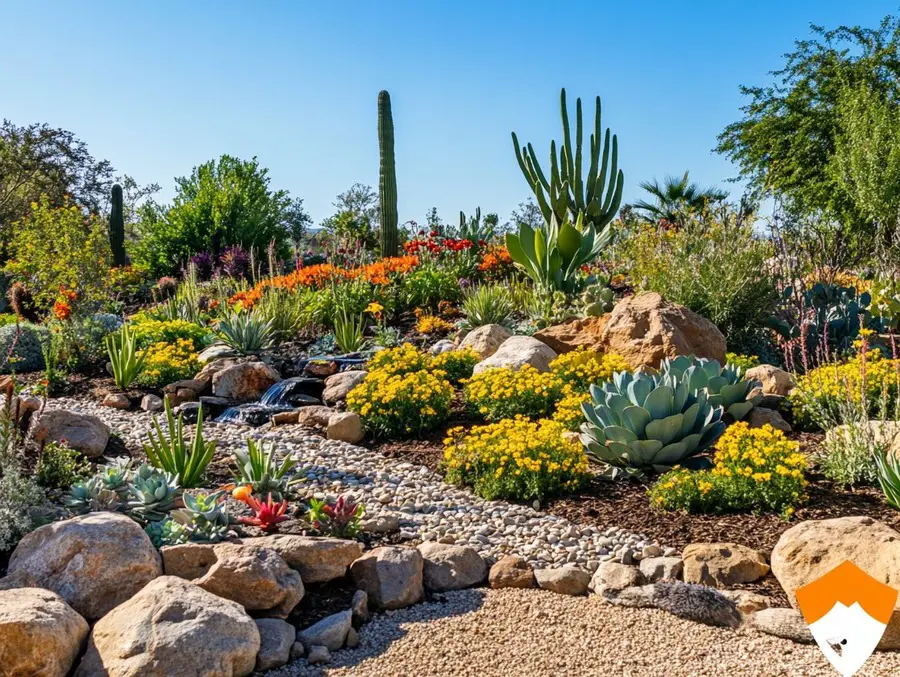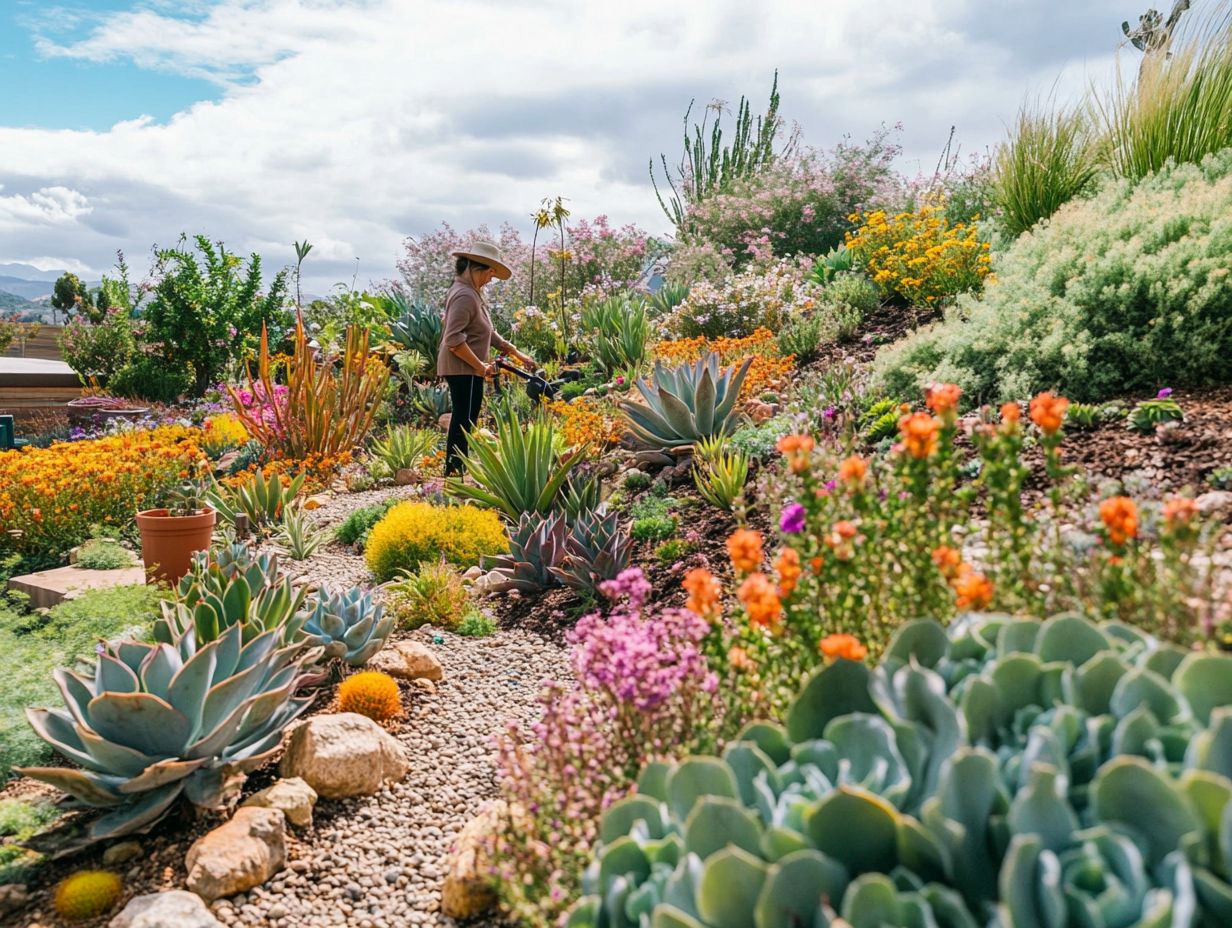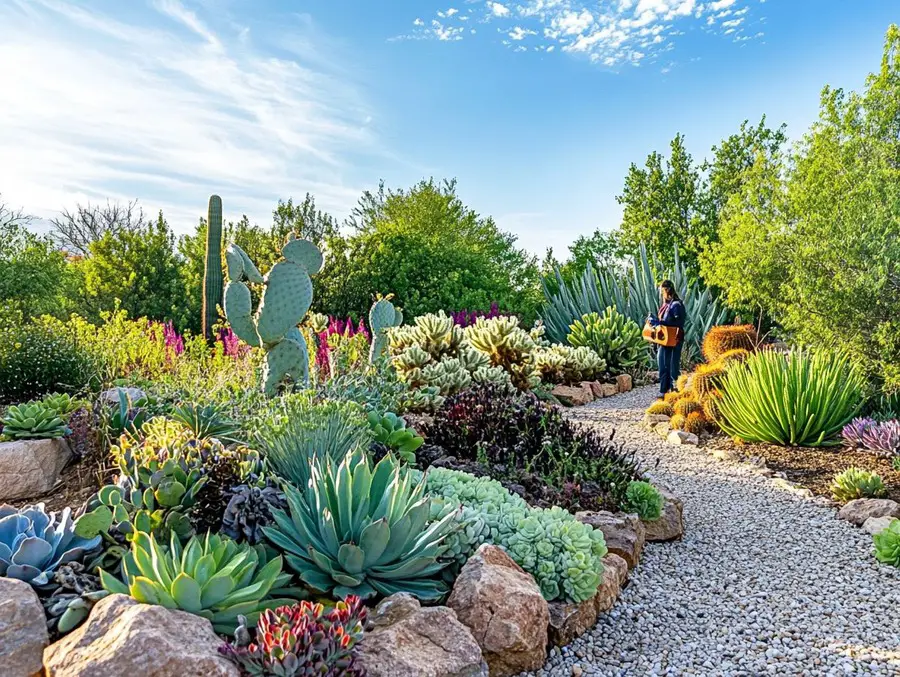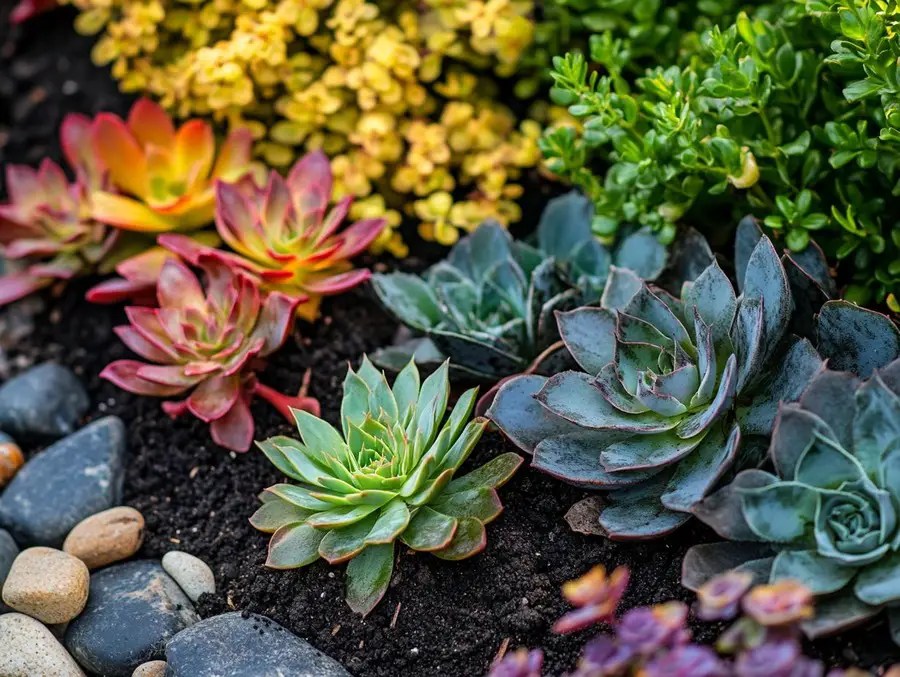We use affiliate links. If you purchase something using one of these links, we may receive compensation or commission.
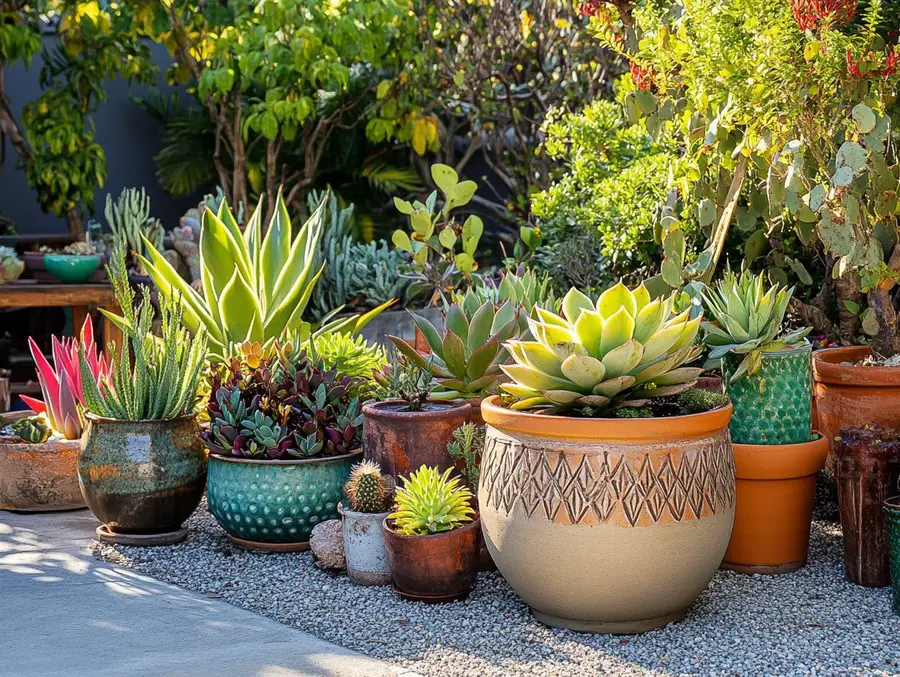
Container Plants for Xeriscaping offer a smart way to create a beautiful, water-wise garden even in small spaces.
Struggling to keep plants alive in dry conditions? Traditional gardens demand constant watering, but with the right container plants, you can design a stunning, low-maintenance landscape that thrives in drought.
Let’s explore the best options to make your xeriscape both vibrant and sustainable!
Container Plants for Xeriscaping Key Takeaways
- Container Plants for Xeriscaping are drought-tolerant plants grown in pots for water-efficient gardening.
- Popular choices include succulents, ornamental grasses, and native perennials.
- These plants require minimal water, making them ideal for patios, small spaces, and arid landscapes.
- Using well-draining soil and strategic placement ensures a thriving, sustainable container xeriscape.
Container Plants for Xeriscaping: Easy-Care & Drought-Resistant
Xeriscaping is a fantastic way to garden sustainably while conserving water and creating beautiful outdoor spaces.
By using drought-resistant plants and smart design strategies, you can enhance your garden’s look and significantly cut down on water usage.
This article will dive into container plants for xeriscaping, covering how to choose the right plants, tips for keeping them healthy, and some creative design ideas to make your garden both stunning and water-wise.
Get ready to discover how to create a thriving, eco-friendly garden that thrives in dry conditions!
What is Xeriscaping?
Xeriscaping is a sustainable landscaping approach that focuses on saving water by choosing drought-resistant plants, using efficient irrigation systems, and taking into account the unique climate zones in your area.
This gardening method helps you maintain an eco-friendly garden and boosts the visual appeal of your outdoor spaces.
By carefully selecting a variety of native plants, ornamental grasses, and eco-friendly gardening practices, you can create a beautiful landscape that thrives with minimal water usage.
Definition and Benefits
Xeriscaping is all about choosing the right plants, mainly drought-resistant and native species, so you can create beautiful landscapes that thrive on minimal water.
This approach works wonders for your garden and brings significant benefits to the environment and local ecosystems.
By adopting this sustainable gardening method, you’re conserving precious water resources, which is especially important in dry areas.
It promotes biodiversity by offering habitats for various wildlife.
You’ll also find that xeriscaping reduces the need for chemical fertilizers and pesticides, promoting a healthier ecosystem that supports pollinators and beneficial insects.
One of the best parts? Xeriscaped gardens require less maintenance, allowing you to enjoy your outdoor spaces without the constant hassle of traditional lawn upkeep.
With a focus on local plants that are perfectly suited to your environment, xeriscaping is a practical way to boost your outdoor aesthetics while helping the planet stay healthy.
Choosing Container Plants for Xeriscaping
When you’re picking container plants for xeriscaping, it’s important to think about a few key factors like the size of the container, drainage, and the specific soil types that work best for drought-tolerant plants.
This will help ensure successful growth and sustainability in your garden design.
Factors to Consider
When you’re selecting the right container plants for xeriscaping, it’s important to consider factors like soil pH, drainage materials, and sunlight requirements to create a thriving environment for your drought-resistant plants.
Understanding these variables is key to promoting healthy growth and maximizing the lifespan of your plants in limited water conditions.
Soil pH is a big deal when it comes to nutrient availability as certain plants thrive in specific pH ranges, so it pays to do your homework.
Using the right drainage materials, like gravel or perforated pots, can help prevent waterlogging, which is the last thing you want because it can lead to root rot.
Don’t forget to check sunlight exposure too; some drought-tolerant plants love soaking up the full sun, while others prefer a bit of partial shade.
By tailoring these elements to match the plants you choose, you can set yourself up for a sustainable and successful container garden that flourishes, even with minimal water.
Types of Container Plants for Xeriscaping
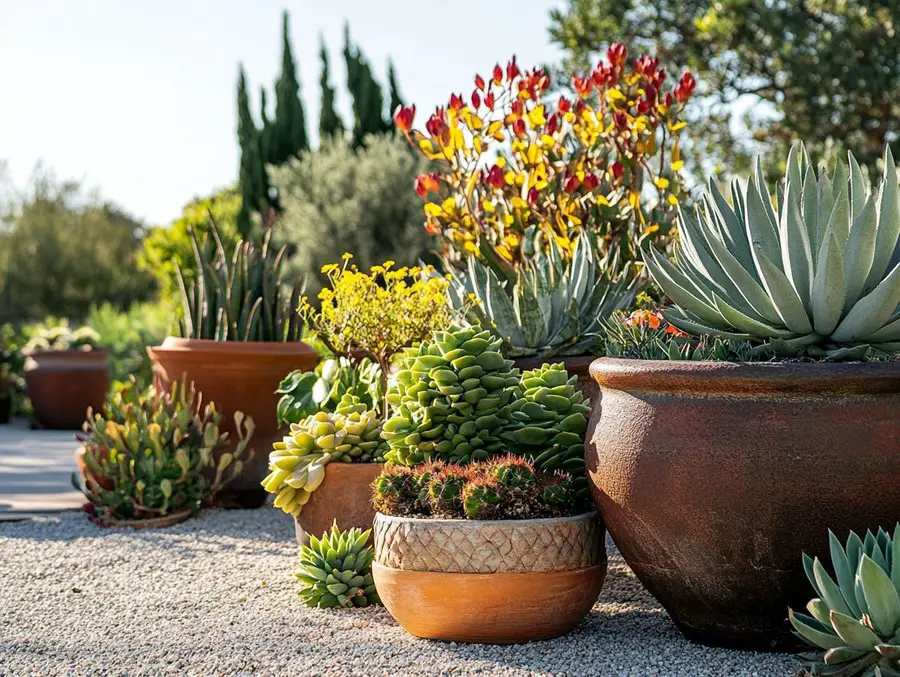 When you’re looking into container plants for xeriscaping, you’ve got a whole bunch of options to choose from.
When you’re looking into container plants for xeriscaping, you’ve got a whole bunch of options to choose from.
Think succulents, drought-tolerant flowers, ornamental grasses, cacti, and both perennials and annuals.
These plants can help you create a vibrant and resilient garden space that thrives even in dry conditions.
Succulents
Succulents are a fantastic choice for xeriscaping because they have this cool ability to store water, making them perfect plants for drought resistance and container gardening.
These tough little guys come in all sorts of shapes, sizes, and colors, which means you can create stunning visual combinations in your garden design.
For example, Echeveria and Sedum species have vibrant rosettes, while Agave and Aloe bring in bold architectural shapes.
Their maintenance is a breeze. You usually just need to give them occasional watering and provide well-draining soil, making them ideal for anyone looking for a low-maintenance gardening option.
And let’s not forget the seasonal magic, many succulents burst into captivating blooms, adding pops of color that attract pollinators and elevate the overall beauty of your landscape.
Drought-Tolerant Flowers
Drought-tolerant flowers are a fantastic way to add vibrant color and seasonal interest to your xeriscaping while requiring minimal water to thrive.
They’re an excellent choice for eco-friendly gardening.
Among these standout varieties, you’ll discover the bright yellows of California poppies, the striking blues of blue flax, and the rich purples of lavender.
Each of these flowers brings its unique flair to any landscaping project you take on.
Not only do they look amazing, but they also pair beautifully with the textures of ornamental grasses and succulents.
These flowers don’t just turn heads; they also enhance biodiversity in your garden by providing food and habitat for pollinators like bees and butterflies, which helps support local ecosystems.
These resilient species can thrive in various soil types while reducing runoff and conserving water, making them essential for your sustainable landscaping efforts.
Grasses and Shrubs
Incorporating ornamental grasses and hardy shrubs into your xeriscaping design can really amp up the visual appeal of your landscape while also boosting biodiversity and creating habitats for native wildlife.
These drought-resistant plants come in all shapes and sizes.
Some grasses can reach up to four feet tall, while low-growing shrubs might only hit a foot.
This variety gives you the chance to create a layered garden effect.
Imagine taller grasses like Miscanthus giganteus serving as a stunning backdrop for shorter native shrubs like Salvia and Rudbeckia.
Combining these elements helps you achieve a cohesive design and cuts down on maintenance.
Many of these species thrive with minimal water and care once they’re established.
These thoughtful pairings can attract beneficial insects and pollinators, really enhancing the ecological value of your landscape.
Tips for Maintaining Container Plants in Xeriscaping
To keep your container plants thriving in a xeriscaping setup, it’s important for you to establish a consistent watering schedule, use the right fertilization techniques, and apply effective pest management strategies.
These steps are essential for successful organic gardening.
Watering and Fertilizing
Establishing a proper watering schedule and understanding the fertilization needs of your container plants is crucial for keeping your soil healthy, ensuring moisture retention, and promoting growth.
Try using various watering techniques like drip irrigation or soaker hoses to optimize your water usage, especially if you’re into xeriscaping.
These methods deliver moisture straight to the soil and roots, cutting down on evaporation and runoff.
Incorporating organic soil amendments, such as compost or mulch, can do wonders for your soil structure and boost beneficial microbial activity, which is great for plant vitality.
In terms of fertilization, picking slow-release or organic fertilizers designed for drought-resistant species is key.
This approach complements your watering techniques and supports sustainable gardening.
By combining these practices, you can create an eco-friendly landscape that thrives with minimal resources.
Pest and Disease Control
Effective pest management and disease control are essential for keeping your container plants safe in xeriscaping.
It’s all about blending organic gardening techniques with some proactive monitoring.
When you learn to identify pests early, you can jump into action before those infestations have a chance to spread.
This is especially important if you’re going for a maintenance-free gardening approach.
Regularly checking your plants for signs of distress, like discoloration or damaged leaves, gives you the power to maintain a healthier ecosystem.
Using techniques like companion planting can really boost biodiversity in your garden.
It attracts beneficial insects that love to snack on common pests.
Introducing organic solutions like neem oil or insecticidal soap can help treat and prevent infestations while keeping the environment safe.
By emphasizing these natural strategies, you protect your container gardens and promote sustainable practices that enhance the overall health of your garden.
Design Ideas for Container Plants in Xeriscaping
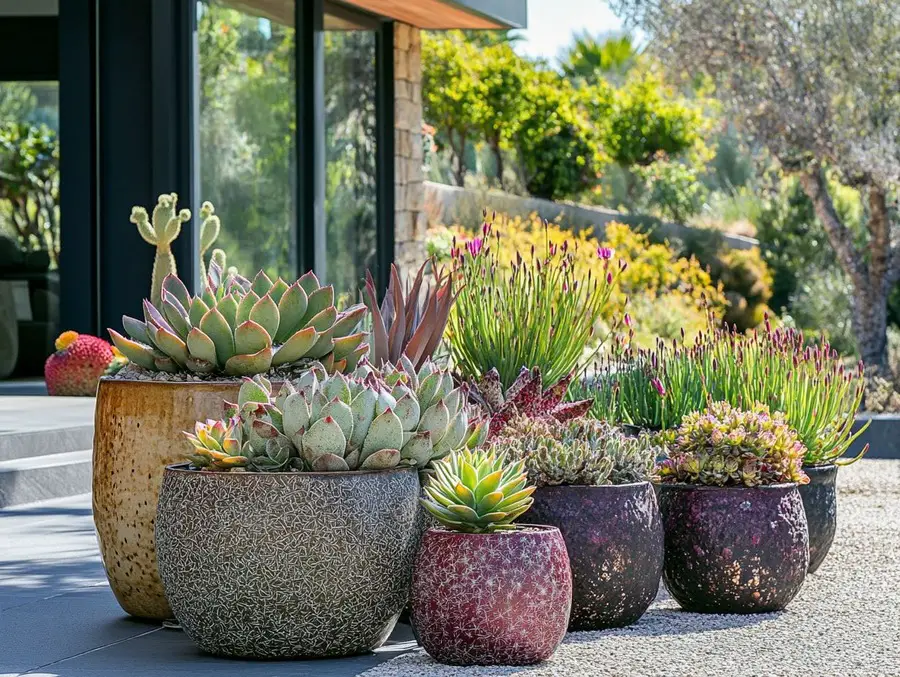 Creating a water-wise garden with container plants opens up a whole new world of design possibilities for you.
Creating a water-wise garden with container plants opens up a whole new world of design possibilities for you.
You can create stunning visual interest by mixing innovative garden architecture with unique plant combinations that are perfect for xeriscaping.
Creating a Water-Wise Garden
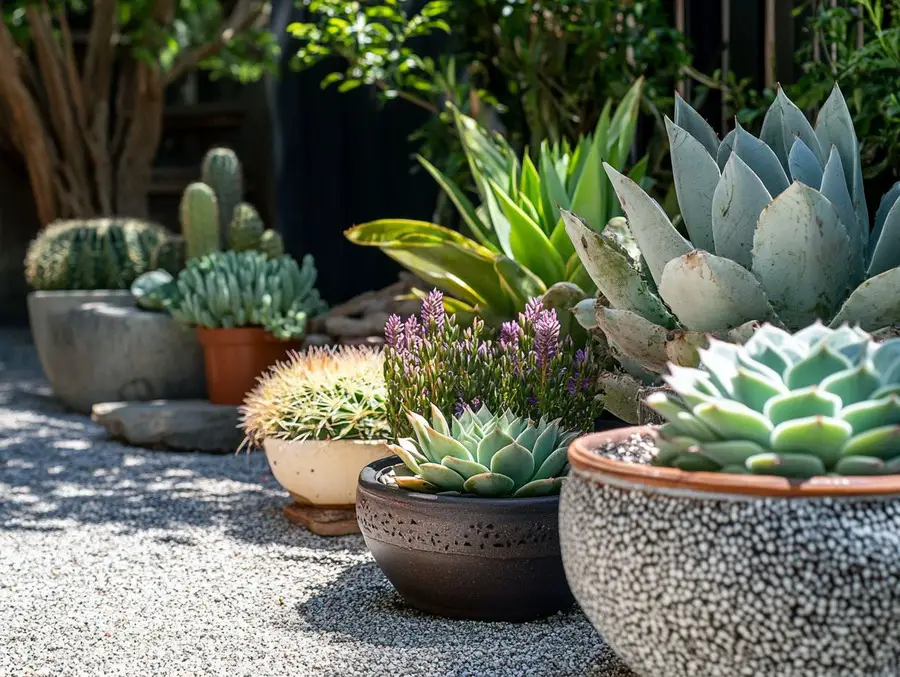 Creating a water-wise garden is all about choosing drought-tolerant plants and using smart design techniques that maximize water efficiency while keeping your landscape looking attractive and sustainable.
Creating a water-wise garden is all about choosing drought-tolerant plants and using smart design techniques that maximize water efficiency while keeping your landscape looking attractive and sustainable.
To get started, think about picking native species that are already well-suited to your local climate and soil.
This way, they’ll need less maintenance and watering.
Grouping plants based on their watering needs can really boost the overall efficiency of your garden.
It allows you to focus your irrigation efforts where they’re needed most.
Don’t forget about mulch! It helps conserve moisture, but it also keeps those pesky weeds at bay, promoting a healthier garden ecosystem.
Using drip irrigation systems can be a game changer.
They deliver moisture directly to the roots, cutting down on evaporation and runoff, which means you’re aligning your garden with sustainable practices and reaping long-term environmental benefits.
Combining Container Plants with Other Xeriscaping Techniques
Combining container plants with other xeriscaping techniques can help you create a diverse, low-maintenance garden that conserves water and also boosts the beauty of your landscape.
This approach lets you get creative with limited spaces while considering the specific environmental conditions in your area.
By incorporating elements like mulching, you can effectively reduce evaporation and keep those pesky weeds at bay, creating a thriving ecosystem for your container plants.
Using organic amendments is a great way to enrich the soil, ensuring that your plants don’t just survive but actually flourish.
When you choose climate-adaptive plants, you’re setting up a solid foundation for a sustainable landscape.
These species are well-suited to your local climate and require less water, making them perfect allies in your mission to conserve resources while still maximizing visual appeal.
Frequently Asked Questions
What are container plants for xeriscaping?
Container plants for xeriscaping are plants that are specifically chosen and grown in containers for use in xeriscaping, a landscaping technique that focuses on conserving water and using drought-resistant plants.
Why use container plants for xeriscaping?
Using container plants for xeriscaping allows you to have a diverse range of drought-resistant plants in a limited space, making it ideal for small yards or balconies.
It also allows for easy maintenance and flexibility in rearranging the plants.
What types of plants are suitable for container xeriscaping?
Plants that are suitable for container xeriscaping include succulents, cacti, herbs, and ornamental grasses.
These plants have adapted to survive in dry and arid conditions, making them perfect for xeriscapes and containers.
How do I care for container plants in xeriscaping?
Container plants in xeriscaping require minimal care compared to traditional gardens.
Water them deeply and infrequently, as they prefer to dry out between watering.
Fertilize them with a slow-release fertilizer once a year and prune them as needed.
Can I use any type of container for xeriscaping plants?
Yes, you can use various types of containers for xeriscaping plants, such as terracotta pots, ceramic pots, and even repurposed containers such as buckets or old tires.
Just make sure the container has proper drainage holes for excess water to drain out.
What are some recommended container plants for xeriscaping?
Some recommended container plants for xeriscaping include yucca, agave, lavender, rosemary, sedum, and ornamental grasses like muhly grass.
These plants are low maintenance, drought-resistant, and add visual interest to your xeriscape.
Best Plants for Xeriscape Gardens: Hardy & Beautiful
Xeriscape Garden Styles: Easy Low-Maintenance Options
Xeriscape Gardening Techniques: Easy Low-Water Tips
Xeriscape Garden Design & Layout: Easy Water-Wise Beauty
What is xeriscaping? A beginner’s guide to drought-tolerant landscaping – Colorado State University
Related Content
Visit my Amazon Influencer Page for videos and gardening products Grow Your Own Garden

